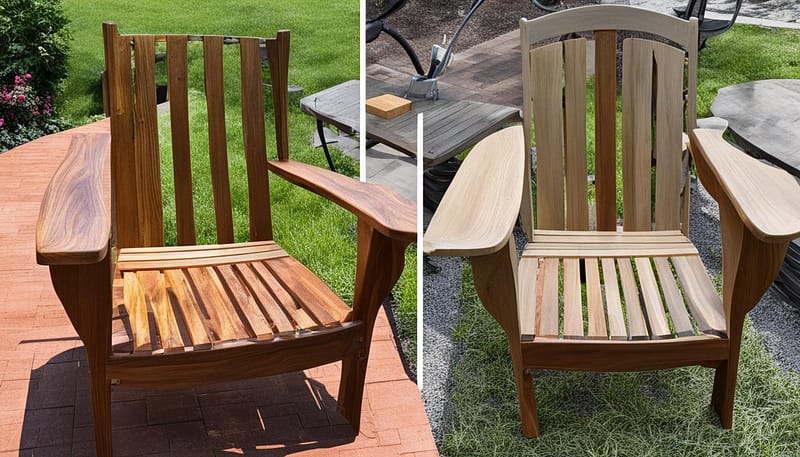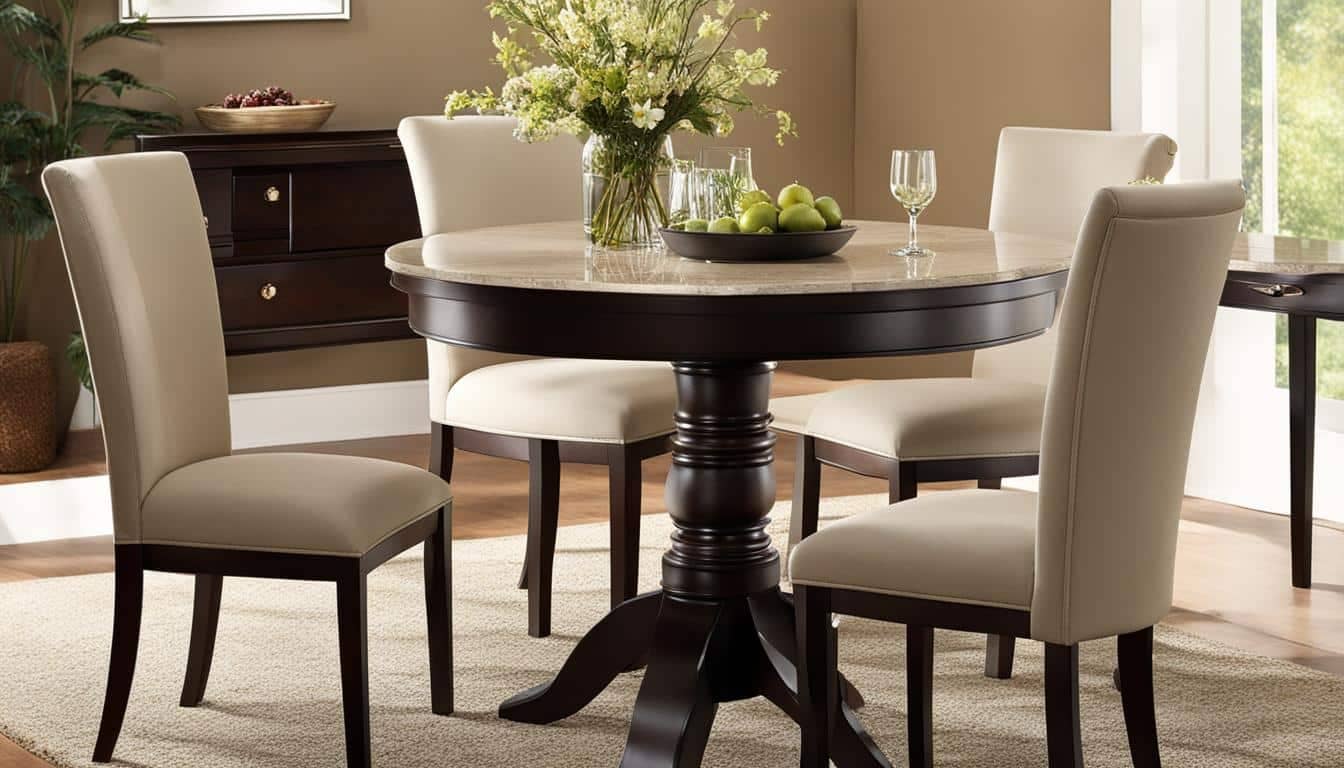Are you looking to protect and enhance the appearance of your outdoor furniture? Linseed oil can be a great solution. In this guide, we will walk you through the process of applying linseed oil to your outdoor furniture with ease.
Linseed oil, especially boiled linseed oil, is a popular choice for preserving and beautifying wooden outdoor furniture. It provides a rich finish that adds character and depth to the wood. The process of applying linseed oil may seem daunting, but with the right steps, you can achieve a professional-looking result.
Before we dive into the application process, let’s take a closer look at the benefits of using linseed oil for outdoor furniture:
- Protects outdoor furniture from the elements
- Enhances the natural beauty of the wood
- Provides a rich and durable finish
- Easy to apply and maintain
- Can be used on a variety of wood types
Now that we understand the benefits, let’s move on to the step-by-step guide on how to apply linseed oil to your outdoor furniture. Follow these instructions, and you’ll have your furniture looking brand new in no time!
Key Takeaways:
- Linseed oil is a popular choice for protecting and enhancing outdoor wooden furniture.
- Boiled linseed oil is easier to apply and dries faster than pure linseed oil.
- Prepare the wood surface by sanding it to a fine grit and raising the grain.
- Apply linseed oil using a clean rag or brush, wiping away excess oil.
- Multiple coats may be necessary, allowing each coat to dry before applying the next.
Understanding Linseed Oil for Outdoor Furniture
Linseed oil is a versatile product that has been used for centuries to treat and protect wood. When it comes to outdoor furniture, there are different types of linseed oil to consider. Pure linseed oil is thick and slow to dry, making it impractical for outdoor use. Boiled linseed oil, on the other hand, has additional additives that enhance its application and drying properties.
It is important to note that most boiled linseed oil products on the market today do not actually undergo the process of boiling but instead contain chemical additives for drying time and thinning the oil. These products are no longer considered green or food-safe. However, there is a newer option called purified linseed oil, which is boiled without any chemical additives and is both green and food-safe.
When choosing the type of linseed oil for your outdoor furniture, consider your needs and preferences. Boiled linseed oil offers ease of application and faster drying time, while purified linseed oil provides a green and food-safe option. Whichever option you choose, linseed oil can provide a beautiful finish that enhances the natural beauty of your outdoor wooden furniture.
How to Prepare Wooden Outdoor Furniture for Linseed Oil
Before applying linseed oil to your wooden outdoor furniture, it is crucial to properly prepare the wood surface. This will ensure that the oil adheres properly and provides optimal protection. Here are the steps to prepare your furniture:
Sanding the Wood
Start by sanding the wood surface to a fine grit, typically between 320 and 400. This will help remove any rough patches, splinters, or imperfections on the surface. Even if the wood feels smooth, it is still recommended to sand it to ensure better absorption of the oil. Use sandpaper or a sanding block to achieve a smooth and even finish.
Cleaning the Wood
After sanding, it is important to clean the wood surface to remove any dust or debris. Wipe down the furniture with a clean, damp cloth to ensure a clean surface for the linseed oil application. This step is essential for achieving a smooth and flawless finish.
Raising the Grain
To further enhance the smoothness of the wood surface, you can also consider raising the grain. This involves dampening the wood with water and allowing it to dry completely before sanding again. Raising the grain helps prevent the wood from absorbing excess oil and ensures a more uniform application.
By following these steps and properly preparing your wooden outdoor furniture, you can ensure that the linseed oil application is successful and the wood is well-protected.
Note: The image above represents the process of preparing wooden outdoor furniture for linseed oil. It is important to follow the steps mentioned in the text for optimal results.
Step-by-Step Guide: How to Apply Linseed Oil to Outdoor Furniture
Applying linseed oil to your outdoor furniture is a simple process that can help protect and enhance its appearance. Follow these steps to achieve the best results:
- Clean the furniture: Before applying linseed oil, make sure the furniture is clean and free from any dust or debris. Wipe it down with a damp cloth or use a small amount of soapy water to remove any dirt.
- Sand the surface: To ensure a smooth finish, lightly sand the surface of the furniture using a fine-grit sandpaper. This will help the oil penetrate the wood and create a more even coat.
- Apply the linseed oil: Dip a clean cloth or brush into the linseed oil and apply a thin, even coat to the furniture. Make sure to cover all surfaces, including the undersides and hard-to-reach areas. Allow the first coat to dry completely before applying additional coats.
- Wipe away excess oil: After applying each coat, use a clean cloth to wipe away any excess oil. This will prevent the oil from pooling or leaving a sticky residue on the surface of the furniture.
- Repeat the process: Depending on the current condition of your furniture, you may need to apply multiple coats of linseed oil. Repeat the application process, allowing each coat to dry fully, until you achieve the desired finish.
Extra Tip:
If you prefer a glossy finish, you can buff the furniture with a soft cloth after the final coat has dried. This will give the wood a beautiful shine.
Remember to always follow the manufacturer’s instructions when applying linseed oil to your outdoor furniture. Allow the oil to dry fully before using the furniture to ensure a durable and long-lasting finish.
Conclusion
In conclusion, using linseed oil for outdoor furniture is a fantastic way to protect and maintain its beauty for years to come. Whether you opt for boiled linseed oil or purified linseed oil, both options offer benefits for your outdoor furniture. By properly preparing the wood surface and applying linseed oil in thin, even coats, you can provide a protective barrier against the elements and enhance the natural appearance of the wood.
Regular maintenance is key to preserving the linseed oil finish on your outdoor furniture. This includes regular cleaning with a damp cloth or mild soapy water to remove dirt and debris. Avoid using strong cleaners or solvents that can strip away the oil finish. Additionally, it is recommended to reapply linseed oil once a year, or more frequently for heavily used furniture, to keep the wood nourished and protected.
Remember to follow the manufacturer’s instructions and allow the linseed oil to fully dry and harden before using your outdoor furniture. With proper care and maintenance, your furniture will withstand the test of time and continue to bring enjoyment to your outdoor space.
FAQ
Is boiled linseed oil safe for outdoor wooden furniture?
Boiled linseed oil is a popular choice for outdoor wooden furniture. However, it’s important to note that most boiled linseed oil products on the market today contain chemical additives and are not considered green or food-safe. If you prefer a green and food-safe option, you can choose purified linseed oil, which is boiled without any chemical additives.
How do I prepare wooden outdoor furniture for linseed oil?
To prepare wooden outdoor furniture for linseed oil, it is recommended to sand the wood surface to a fine grit (between 320 and 400) to remove any rough patches or splinters. Additionally, clean the wood surface by wiping away any dust or debris using a clean, damp cloth.
How do I apply linseed oil to outdoor furniture?
Applying linseed oil to outdoor furniture is a relatively simple process. After preparing the wood surface, you can apply linseed oil using a clean rag or a brush. It’s important to apply thin, even coats and wipe away any excess oil. Multiple coats may be necessary, with each coat being allowed to dry before applying the next.
How do I maintain the linseed oil finish on outdoor furniture?
To maintain the linseed oil finish on outdoor furniture, regular cleaning and reapplication are necessary. Clean the wood treated with linseed oil by wiping it down with a damp cloth or using a small amount of soapy water. Avoid using strong cleaners or solvents. Regular reapplication of linseed oil is also recommended, especially for furniture exposed to direct sunlight or high traffic areas.
How often should I reapply linseed oil to outdoor furniture?
It is generally advised to reapply linseed oil once a year or even twice a year for heavily used furniture. Signs that the finish needs to be resealed include the wood turning lighter in color or feeling dry to the touch.








